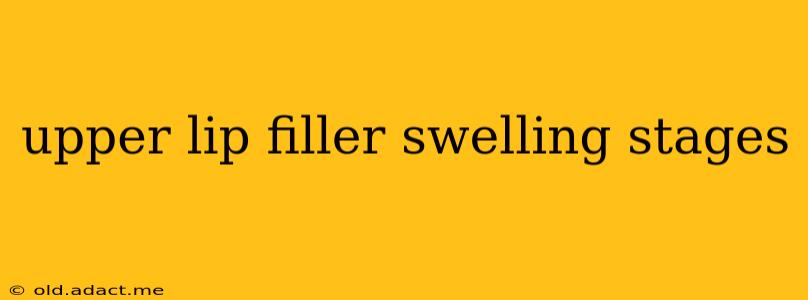Getting lip fillers is a popular cosmetic procedure, offering a subtle or dramatic enhancement depending on your desired outcome. However, swelling is a common side effect, and understanding the stages of swelling after an upper lip filler injection is crucial for managing expectations and ensuring a smooth recovery. This guide will walk you through the typical swelling stages, offering insights to help you navigate this process.
What to Expect Immediately After Treatment
Immediately following your upper lip filler injection, you might experience some immediate swelling, redness, and tenderness. This is a normal reaction to the injection and the introduction of a foreign substance into the lip tissue. The degree of initial swelling varies from person to person, depending on factors like the amount of filler used, the injection technique, and individual sensitivity. Don't be alarmed if your lips feel a bit numb; this is also a common temporary side effect of the local anesthetic often used during the procedure.
Stage 1: The First 24-48 Hours – Peak Swelling
The first 24 to 48 hours are typically when swelling is at its most noticeable. You might find your upper lip significantly larger and more puffy than usual. This is the body's natural response to the filler and the minor trauma of the injection. Applying ice packs to the area in 15-minute intervals can help reduce swelling and discomfort during this initial stage. Avoid strenuous activity and excessive facial expressions, as these can exacerbate swelling.
Stage 2: Days 3-7 – Gradual Reduction
From day 3 to 7, you'll usually see a gradual reduction in swelling. The puffiness will start to subside, and your lips will begin to look more natural. While the swelling may still be noticeable, it will be significantly less than in the first 48 hours. Continue to follow your practitioner's aftercare instructions, such as avoiding alcohol and excessive sun exposure.
Stage 3: Weeks 2-4 – Near-Complete Resolution
By week 2, most of the swelling should have subsided. You'll likely see a significant improvement in the appearance of your lips, with the final result becoming increasingly clear. However, some minor swelling might persist for a few more weeks. It’s important to be patient during this phase as the filler settles naturally into the lip tissue.
Stage 4: Beyond 4 Weeks – Final Results
After about four weeks, the majority of the swelling should have completely resolved, and you'll be able to appreciate the final outcome of the treatment. The results of lip filler are typically long-lasting, but the exact duration varies depending on the type of filler used and individual metabolism.
How Long Does Upper Lip Filler Swelling Last?
The duration of upper lip filler swelling can vary, but generally, you can expect the majority of the swelling to resolve within 2-4 weeks. However, individual experiences can differ. Factors like the amount of filler used, the individual's body's response to the filler, and adherence to post-treatment instructions can all affect the healing process and the duration of swelling.
What Can I Do to Minimize Swelling After Upper Lip Filler?
Several strategies can help minimize swelling after upper lip filler:
- Ice packs: Apply ice packs to the area in 15-minute intervals during the first 24-48 hours.
- Elevation: Keep your head elevated whenever possible during the first few days.
- Avoid strenuous activity: Refrain from intense exercise or activities that increase blood flow to the face.
- Limit alcohol consumption: Alcohol can increase inflammation, so it's best to limit or avoid alcohol consumption.
- Follow your practitioner's aftercare instructions: Carefully follow all the post-treatment instructions provided by your practitioner.
Remember, everyone’s experience with lip filler is unique. If you have concerns or experience excessive swelling or bruising, it’s vital to contact your medical practitioner. They can assess your situation and provide appropriate guidance.
